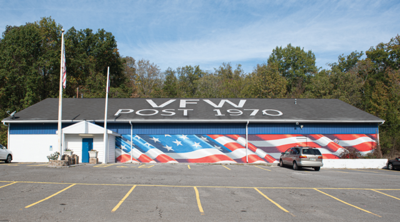
VFW Post 1970 on Charlotte Pike
The Big Six is shrinking.
Disabled American Veterans, Veterans of Foreign Wars, American Legion, Paralyzed Veterans of America, Amvets and Vietnam Veterans of America are the oldest and largest of the 40,000 or so veterans service organizations registered with the Internal Revenue Service. Chartered by Congress, the Big Six have their power and influence baked into the United States’ veterans policy. For example, all are recognized by the Department of Veterans Affairs to advocate for their members’ VA claims. All have an active and long-running lobbying presence on Capitol Hill and in statehouses nationwide.
These groups are woven into the fabric of American life. In the mind’s eye, a veteran is often marching on parade in the distinctive garrison cap of the VFW or Legion. The DAV and Amvets are recipients of clothing donations.
Nevertheless, membership in the groups has been declining for decades. After a massive surge following World War II and the Korean War, the then-Big Five struggled to recruit veterans coming home from Vietnam. There were a multitude of factors in play. Unlike their World War II counterparts, Vietnam vets were met with no cheering throngs as they returned home from Southeast Asia. A general disillusionment with the conflict — among society at large and the veterans themselves — led many vets to wish to simply fade into the background. Further, many Vietnam veterans felt unwelcome at the VFW and Legion halls of their fathers. Because of this, the Veterans Administration added the Vietnam Veterans of America, founded in 1978, to its list of preferred veterans service organizations, making the Big Five into the Big Six.
Broadly, membership recovered, both due to the new addition and because the new and massive cohort of vets found themselves struggling with the labyrinth of VA regulations. They needed the assistance provided by veterans service organizations.
Membership peaked in the early 1990s, but since has faced a sharp decline. Older vets have died off, and the end of the draft in the 1970s means there are fewer vets in general. As the 20th century gave way to the 21st, the VSOs faced the same problems as other legacy civil society groups — Gen Xers and millennials are far less likely to be joiners.
Even so, things have actually started to recover. The VFW snapped a 27-year membership decline in 2018, netting 25,000 members to bring its total to 1.165 million — still a million fewer than its 1992 peak, but an encouraging sign.
But there’s more to it than just generational differences. Big Six officials say many younger veterans fail to see the benefits of VSOs. In a time when veterans don’t face the societal opposition that prevailed during the Vietnam era, many young vets don’t see the need to seek the protection and camaraderie of the Legion Hall. At a time when VA benefits can be applied for with the click of a mouse, navigating the paperwork maze is far less daunting. Benefits like the G.I. Bill seem invincible, and it often seems inconceivable that vets would be in danger, or that anyone would even need to lobby for their protection.
New groups have sprouted up as well, aimed at younger vets and focusing their spending and energy on service and education, rather than maintaining infrastructure like meeting halls or on lobbying and advocacy efforts.
The new groups — like Student Vets, and the Iraq and Afghanistan Veterans of America — have narrower focuses than the older groups. Groups like Team Red, White and Blue are based more on social connections and service projects than advocacy.
According to a study from the nonpartisan Center for a New American Security, nonprofits that serve veterans generate more than $3.6 billion in revenue annually. While the Big Six account for a staggering 68 percent of that, their revenues grow only around 2 percent a year, while nonprofits founded after Sept. 11, 2001, have 15 percent annual growth — even though they spend a paltry amount on lobbying compared to the Big Six.
Dan Collins, an account executive with FW Publishing (parent company of the Scene), has worked to bring in younger veterans to the VFW and Legion in Middle Tennessee. To him, there’s one big change the legacy groups could make to draw in younger members.
“The first and foremost thing is they have to stop smoking,” he says. “Tell all the post-9/11 vets, ‘We’ve stopped smoking.’ There are so many [Global War on Terror] vets that don’t smoke, and they want to bring their wives or girlfriends.”
Collins says that seemingly simply change would show millennial vets that the VFW and Legion want them to be involved. He says those groups essentially have a branding problem with the younger generation.
“The number one obstacle is lack of interest from the millennial age,” Collins says. “The brand of the VFW and the Legion is an old smoky bar with angry men. They just haven’t had the knowledge to turn that around until recently. They didn’t prepare for the change.”
Collins says younger vets want something more family-oriented. He points to a VFW post in Colorado that offers day care and automobile repair services.
“It’s a beacon of resources, and that would be very well-received, to be the antithesis of the bar and the smoke,” he says.
He also says the groups must do a better job of communicating the important work they do in terms of policy creation.
“There is a huge knowledge gap and disconnect as to what these organizations do at an aggregate level,” he says. Without a younger generation of leadership getting involved, “The voice in Washington is going to evaporate.”
And if those longtime voices fall silent, it’s the next generation of veterans who will suffer the consequences.





